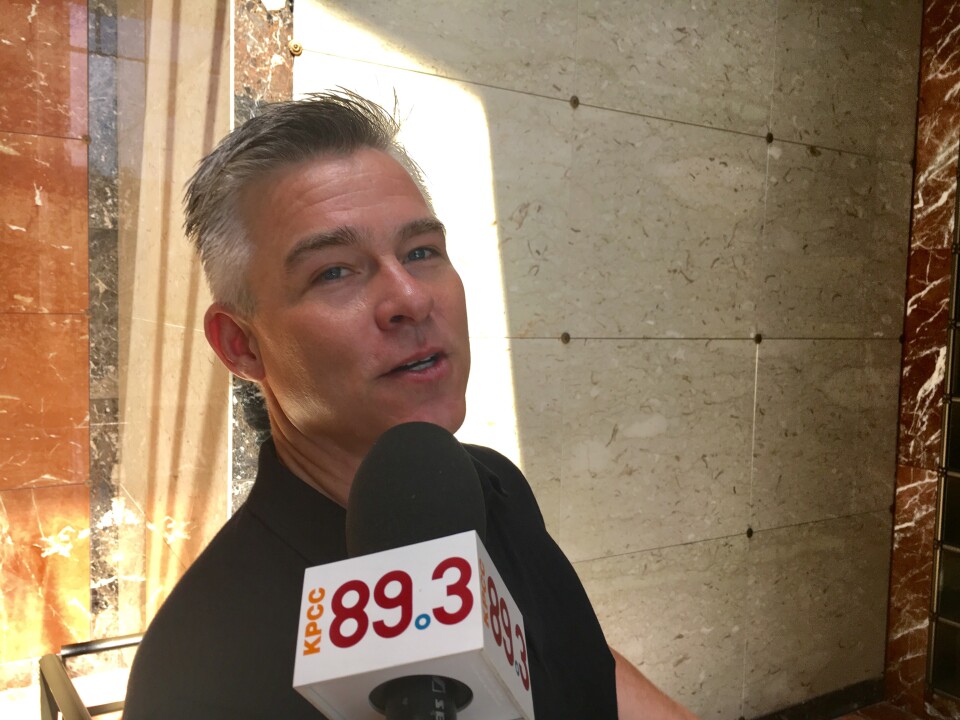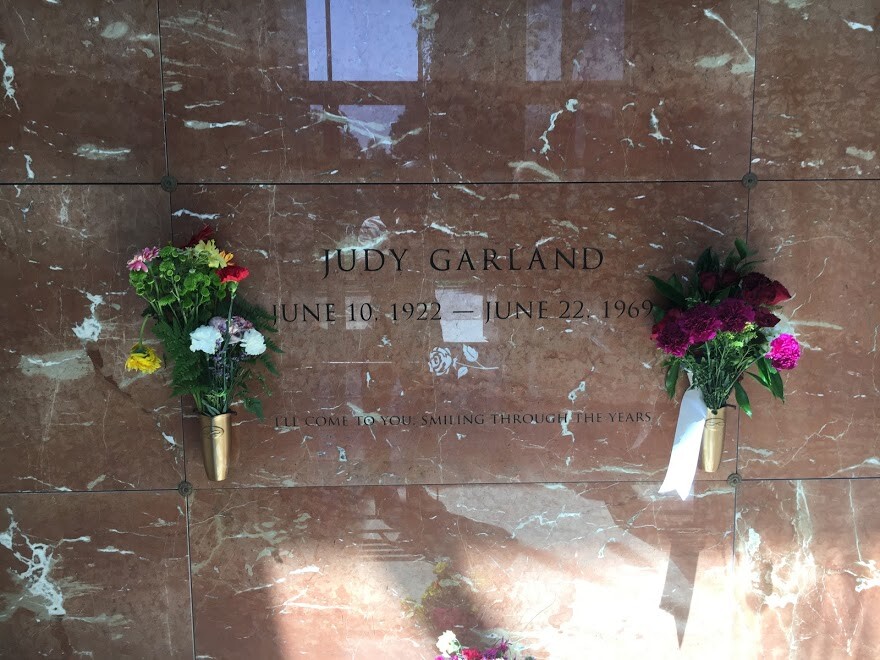Playa del Rey reinstalls a traffic lane after its removal sparks anger, the marijuana industry cozies up to politicians, She Should Run aims to get 250k women running for office by 2030.
LA reverses direction on the Playa del Mar road diet
Traffic is the bane of Southern California, the enemy of Los Angeles.
And boy, do we love to hate it.
But drivers in the beachside community of Playa del Rey are especially peeved about some recent changes to a major road.
Last month, the city closed traffic lanes on Vista Del Mar in an effort to reduce speeding and collisions on the street.
Drivers, however, say the changes snarled traffic so bad that they started a campaign to reverse the process.
"There was a lot of understandable anger and frustration over the lane closure," says L.A. city councilman Mike Bonin.
The city backed down today and announced it will soon take out a parking lane to recreate two lanes of traffic in each direction, again.
"This has been an extreme case, but it reflects a reality that is going to be present any time you want to change major thoroughfares," says KPCC's transportation reporter Meghan McCarty Carino. "I'm sure there will be a huge constituent of people that will hate any kind of changes that the city makes to streets."
And that's especially true with the city's campaign Vision Zero, which aims to redesign L.A.'s roads to be more safe for everyone.
Listen to the full interview by clicking the audio player above.
Correction: The article originally stated that a bike lane was added to Vista del Mar, but that is not accurate.
2 proposed laws aim to close the gender pay gap in CA
Equal pay for equal work has been a stubbornly difficult problem for women, who still make less than men for doing the same job.
And a recent study found that women aren't likely to close the pay gap anytime soon -- it may not happen until the year 2043.
Well, a pair of female lawmakers in California are justifiably dissatisfied with that timeline. They're proposing a pair of new bills to encourage fair pay.
To help us understand the proposed legislation, we spoke with Ange-Marie Hancock Alfaro. She's an associate professor of political science and gender studies at USC.
On the first bill, which would prevent employers from asking about a person's prior salary:
"One of the pieces of logic there is that once you ask a woman and a man candidate what they're making, because they may have been in a situation where they were being paid according to the gender gap in their current job, the new job would kind of continue that gap. So the woman candidate would say, 'I'm making X amount of dollars, I'm making 25 dollars an hour,' and the man candidate would come in and say 'I'm making 35 dollars an hour.' And the employer, interviewing both of them, would then offer the job to the female candidate and say '27 dollars an hour,' and then offer the job to the male candidate at 37 dollars an hour, so the gap that existed before then just persists at the same level. So that's one of the reasons why AB 28 wants to ban employers from asking for salary histories."
On the second bill, which would make large companies publicly post the median salary of male and female employees:
"This is actually one that is designed to repeat and duplicate one of those Obama administration policies that's now under threat. In 2016, the Obama administration said that all large companies have to report publicly their data about their hiring and their wages, so that analyses can be done to see if there's a gender gap - so rather than just assume that there is one, or pretend that there's not one, we need the data to actually see. And what's happening now at the federal level has actually inspired this effort in California to say 'We're going to make this California state law that large companies like Google and Tesla actually have to report their data out so we can see if there's a gender gap.'"
To listen to the full segment, click the blue play button above.
Nonpartisan organization aims to increase number of women in elected office
There are half a million elected positions in the United States, but less than a quarter are currently held by women.
And in California, the numbers are just as bad. Just 26 out of 120 state lawmakers are female - that's a 20-year-low.
Nonpartisan group She Should Run is working to boost these numbers.
They're hoping to increase the number of women in elected office to two hundred and fifty thousand, or half of all elected positions, by 2030.
Erin Loos Cutraro is the Founder and CEO of She Should Run.
"We're just not seeing the increase in the number of women serving that we want to see, so there's some real disconnect in the very beginning stage on the number of women who are even considering running for office in the first place... She Should Run's mission is to expand the talent pool of women running by offering a community, and offering resources and growth opportunities for women who are thinking about running. So much of the narrative right now about this really interesting surge in women that we've seen step up to run since the 2016 election is focused on 2018... Frankly, I don't think we will see huge changes in the percentages of women serving. Change is going to take time, it is not going to happen overnight."
Big pot: Marijuana lobbyists shaping the future of weed in California
California's marijuana lobbyists are shelling out big bucks ahead of next year's governor's race.
The election is more than a year away, but the pot crowd seems to prefer Lieutenant Governor Gavin Newsom: he's raked in a little over $300,000 from cannabis-connected donors. Far more than Antonio Villaraigosa, who has received just $5000. Some might see this as a sign of things to come.
As California moves to regulate the industry, what issues are front-and-center for lobbyists?
Take Two put that question to An-Chi Tsou. She advises on cannabis-related policy for her firm, Tsou Consulting.
Press the blue play button above to hear the full interview.
#SoCalSoCurious: What happens when a cemetery is full?
Sabra Johnson was with her husband at a funeral in Whitter when he took a moment to marvel at the size of the burial ground — a Rose Hills property.
"He was just in awe of all the space. But I'm like, this is California. Eventually, there will be no more space. What happens then?" Johnson said.
The future of our earthly remains is often a subject people push to the furthest corners of their minds. After all, prolonged consideration of mortality regularly leads to an uncomfortable amount of introspection.
But the morbidity of the query didn't deter Johnson from submitting her question to KPCC's #SoCalSoCurious.
"What happens when a cemetery is full?" - Sabra Johnson
Tyler Cassity, president and co-owner of Hollywood Forever Cemetery, volunteered to help answer that question.

"California is one of the leaders in the nation in having a very sound long-term care policy," Cassity said. "It's mandated that whenever a burial takes place, a portion of that payment is put into an endowment care trust."
Once a cemetery is filled, the endowment care trust is designed to handle maintenance of the grounds indefinitely.

The mandate was put in place in 1955. Before then, setting funds aside was optional.
Currently, privately owned cemeteries are required to set aside a minimum of $4.50 per square foot for each grave they sell. For cremation niches, it's $70, and for crypts, it's about $200. The fees are usually paid by the person buying the spot.
Cemeteries are allowed to charge more — many do.
Every year, the Cemetery and Funeral Bureau runs an audit, just to make sure cemeteries are keeping up.
Hollywood Forever Cemetery, which currently holds around 90,000 interments, has about $10 million set aside.

"Even with our water bill, the endowment can take care of the actual maintenance of the cemetery if we all had to leave or if the operations of the business were no more," Cassity says.
But that's unlikely to happen anytime soon. Cassity says he just got approval to build a new community mausoleum and columbarium — a structure that will hold about 25,000 crypts and 25,000 niches. At the current interment rate of about 1,000 per year, he says that the cemetery has another 50 years before it fills up.

Have a question you want KPCC journalists to investigate? Ask below or visit our SoCal. So Curious. page.
For Latino communities living in areas with high air pollution, the cap-and-trade package may not do enough

On Wednesday, Governor Jerry Brown signed the final bill in the cap-and-trade package. This measure would, among other things, empower the California Air Board to identify and monitor areas with high levels of air pollution.
Fifteen miles south, just northwest of Long Beach, is the city of Wilmington, a community sandwiched between several oil refineries. As of 2015, the city is majority Latino, and it’s certainly a contender to be one of those critical areas that the assembly bill would monitor.
A recent study by the Legislative Latino Caucus found that 44% of California’s Latino population live in areas with considerable amounts of air pollution. According to activists and community organizers, Wilmington is one of these areas, and they’ve noticed that the city is plagued by health problems.
“One of our doctors actually named that area the ‘diesel death zone’ because of what he was seeing in his emergency room,” said Martha Dina Argüello in an interview with Take Two host A Martínez. “Folks are experiencing headaches, and nausea, and bloody noses.”
Argüello is the executive director of Physicians for Social Responsibility Los Angeles, and she has spent time on the ground in Wilmington, working with local organizations and helping educate the people who live there on the public health risks of living so close to a refinery. She absolutely supports attempts to monitor and control air pollution, but for her, the latest assembly bill isn’t enough.
“The monitoring that is included in the bill, Well, that's very good,” said Argüello. “And for for those of us who work on policy in Sacramento, that data is important. But we can't sacrifice the lungs of people on the ground so we can have more data. We need to do both.”
To listen to the full interview, hit “play” on the blue media player at the top of the page.
Electric buses get a boost with new SoCal factory
More than a third of California’s greenhouse gas emissions come from transportation — 50 percent if you factor in the refinery of the fossil fuels used to run them. But on Wednesday, a new battery electric bus factory opened its doors here in So Cal to help stem the tide.
"People competing for fossil fuel buses, they are either going to transform or die,” said California Governor Jerry Brown, one of several government officials who joined local business groups Wednesday to usher in the operation of a manufacturing facility capable of building 400 electric buses each year in its 100,000-square-foot space.
“Right now, we are witnessing the creative destruction of dirty buses by the invention and commercialization of clean buses,” said Brown, adding that “we want to help those dirty bus people transform.”
The California Energy Commission kicked in $3 million to get the Proterra factory off the ground and help it feed all-electric buses to West Coast transit agencies, including Foothill Transit, which has been operating electric buses since 2010 and plans to go all electric by 2030. Out of a current fleet of 350 buses, 17 are electric; another 13 are being built at the City of Industry factory and will go into service next month.
"For us, it's important to make this step to protect the environment, to make a sustainable way of transporting customers throughout our service area," said Doran Barnes, executive director of Foothill Transit, which serves 22 cities in the San Gabriel valley from downtown Los Angeles. "It's to be able to provide mobility and do it in a very clean way that has an air quality benefit and also has the benefit of getting people out of cars and into public transportation to improve the quality of life for our communities."
At an average cost of $750,000 per bus, Proterra's electric buses are priced at a premium compared with $470,000 for a bus that runs on natural gas or and $454,000 for a bus that runs on diesel. The advantage of electric buses is in the operation.
A recent study from the National Renewable Energy Laboratory found electric buses to be eight times more energy efficient than buses that run on natural gas. They also use 80 percent fewer spare parts.
"In the future, every mass transit vehicle in California and the U.S. and in most major cities in the world will be zero emissions," said Ryan Popple, CEO of Proterra, which has already sold more than 400 vehicles to 40 different municipal, university and commercial transit agencies in 20 states.
Soon, Proterra hopes to add the Los Angeles Department of Transportation to its list of customers. The LA DOT has said it plans to swap all of its 2,200 natural gas buses to electric by 2030.
According to Governor Jerry Brown, electric buses are a triple win. In addition to cleaning up local air pollution and reducing greenhouse gas emissions, they create jobs. The Proterra factory plans to employ 60 workers by the end of 2017 and 100 by the end of next year.




